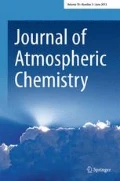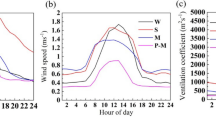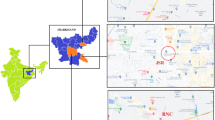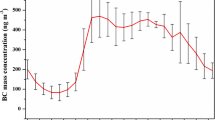Abstract
Black carbon (BC) along with PM2.5 (fine particular matters) plays an important role in the assessment health effect of human beings. Winter season campaign measurements carried out for BC concentrations by using 7 different wavelengths such as 370, 470, 520, 590, 660, 880, and 950 nm, handy aethalometer (AE-33, Magee Scientific, USA), at two different locations i.e., National Institute of Technology, Jamshedpur (NIT J) and Sakchi, Jamshedpur (SAK J), in eastern India. During the study period, the mass concentration of BC varies from 4.19 µgm−3 to 15.36 µgm−3, with an average mean of 8.88 ± 2.40 µgm−3 in NIT J and SAK J, the mass concentration of BC varies from 6.3 µgm−3 to 13.48 µgm−3, with an average mean of 10.29 ± 1.58 µgm−3. However, the concentration of PM2.5 varies from 102.98 µgm−3to 198.21 µgm−3, with an average mean of 155.82 ± 29.98 µgm−3 in NIT J and SAK J, the concentration of PM2.5 varies from 110.83 µgm−3 to 207.65 µgm−3, with an average mean of 169.14 ± 22.40 µgm−3. It was reported that SAK J has a higher BC concentration compared to NIT J. This was due to heavy traffic load and dense population in SAK J. Backward Trajectories were seen that the airborne particulate matter came from differerajeshnt directions. According to the diagnostic ratio analysis of BC, it was observed that most of the BC mass concentrations come from fossil-fuel (69.70%) followed by wood-burning (30.30%) in a particular place. The overall health risk assessment of BC concentration observed during the study period was 26.70, 13.95, 24.95 and 51.32 at NIT J as well as 32.07, 16.72, 29.95 and 61.87 at SAK J, the passive cigarettes comparable concerning the risk of CVM, LC, LBW, and PLEDSC, respectively.





Similar content being viewed by others
References
Ambade, B., Sankar, T. K., Kumar, A., Sethi, S.S.: Characterization of PAHs and n-Alkanes in Atmospheric Aerosol of Jamshedpur City. J. Hazard. Toxic Radioact. Waste 24(2):04020003 (2020)
Andreae, M.O., Gelencs_er, A.: Black carbon or brown carbon? The nature of light-absorbing carbonaceous aerosols. Atmos. Chem. Phys. 6, 3131e3148 (2006)
Ackerman, A.S., Toon, O.B., Stevens, D.E., Heymsfield, A.J., Ramanathan, V., Welton, E.J.: Reduction of tropical cloudiness by soot. Science 288, 1042–1047 (2000)
Allen, G.A., Lawrence, J., Koutrakis, P.: Field validation of a semicontinuous method for aerosol black carbon (aethalometer) and temporal patterns of summertime hourly black carbon measurements in southwestern PA. Atmos. Environ. 33, 817–823 (1999)
Babu, S.S., and K.K. Moorthy.: Aerosol black carbon over a tropical station in India, Geophys. Res. Lett. 29, (23):2098 https://doi.org/10.1029/2002GL015662(2002)
Bond, T.C., Bhardwaj, E., Dong, R., Jogani, R., Jung, S., Roden, C., Streets, D.G., Fernandes, S., and Trautmann, N.: Historical emissions of black and organic carbon aerosol from energy-related combustion, 1850–2000, Global Biogeochem. Cy. 21, GB2018 https://doi.org/10.1029/2006GB002840(2007)
Bond, T.C., Doherty, S.J., Fahey, D.W., Forster, P.M., Berntsen, T., Deangelo, B.J., Flanner, M.G., Ghan, S., K€archer, B., Koch, D., Kinne, S., Kondo, Y., Quinn, P.K., Sarofim, M.C., Schultz, M.G., Schulz, M., Venkataraman, C., Zhang, H., Zhang, S., Bellouin, N., Guttikunda, S.K., Hopke, P.K., Jacobson, M.Z., Kaiser, J.W., Klimont, Z., Lohmann, U., Schwarz, J.P., Shindell, D., Storelvmo, T., Warren, S.G., Zender, C.S.: Bounding the role of black carbon in the climate system: a scientific assessment. J. Geophys. Res. 118, 5380–5552 (2013)
Belis, C.A., Karagulian, F., Larsen, B.R., Hopke, P.K.: Critical review and metaanalysis of ambient particulate matter source apportionment using receptor models in Europe. Atmos. Environ. 69, 94–108 (2013)
Briggs, N.L., Long, C.M.: Critical review of black carbon and elemental carbon source apportionment in Europe and the United States. Atmos. Environ. 144, 409–427 (2016)
Cao, J., Xu, H., Xu, Q., Chen, B., Kan, H.: Fine particulate matter constituents and cardiopulmonary mortality in a heavily polluted Chinese city. Environ. Health Perspect. 120(3), 373–378 (2012)
Cao, J.J., Zhu, C.S., Chow, J.C., Watson, J.G., Han, Y.M., Wang, G.H., Shen, Z.X., An, Z.S.: Black carbon relationships with emissions and meteorology in Xi’an. China. Atmos. Res. 94, 194–202 (2009)
Castanho, A.D.A., Artaxo, P.: Wintertime and summertime Sao Paulo aerosol source apportionment study. Atmos. Environ. 35, 4889–4902 (2001)
Dachs, J., Eisenreich, S.J.: Adsorption onto aerosol soot carbon dominates gasparticle partitioning of polycyclic aromatic hydrocarbons. Environ. Sci. Technol. 34, 3690–3697 (2000)
De Prins, S., Dons, E., Van Poppel, M., IntPanis, L., Van de Mieroop, E., Nelen, V., Cox, B., Nawrot, T.S., Teughels, C., Schoeters, G., Koppen, G.: Airway oxidative stress and inflammation markers in exhaled breath from children are linked with exposure to black carbon. Environ. Int. 73, 440–446 (2014)
Fung, K.: Particulate carbon speciation by MnO2 oxidation. Aerosol Sci. Technol. 12, 122–127 (1990)
Forster, P., Ramaswamy, V., Artaxo, P., Berntsen, T., Betts, R., Fahey, D. W., Haywood, J., Lean, J., Lowe, D. C., Myhre, G., Nganga, J., Prinn, R., Raga, G., Schulz, M., and Van Dorland, R.: Changes in Atmospheric Constituents and in Radiative Forcing. In: Climate Change 2007: The Physical Science Basis. Contribution of Working Group I to the Fourth Assessment Report of the Intergovernmental Panel on Climate Change edited by: Solomon, S., Qin, D., Manning, M., Chen, Z., Marquis, M., Averyt, K. B., Tignor, M., and Miller, H. L., Cambridge University Press, Cambridge, UK and New York, NY, USA (2007)
Florou, K., Papanastasiou, D.K., Pikridas, M., Kaltsonoudis, C., Louvaris, E., Gkatzelis, G.I., Patoulias, D., Mihalopoulos, N., Pandis, S.N.: The contribution of wood burning and other pollution sources to wintertime organic aerosol levels in two Greek cities. Atmos. Chem. Phys. 17, 3145–3163 (2017)
Favez, O., Haddad, E.I.I., Piot, C., Bor_eave, A., Abidi, E., Marchand, N., Jaffrezo, J.-L., Besombes, J.-L., Personnaz, M.B., Sciare, J., Wortham, H., George, C., D’Anna, B.: Inter-comparison of source apportionment models for the estimation of wood burning aerosols during wintertime in an Alpine city (Grenoble, France). Atmos. Chem. Phys. 10, 5295–5314 (2010)
Fuller, G.W., Tremper, A.H., Baker, T.D., Yttri, K.E., Butterfield, D.: Contribution of wood burning to PM10 in London. Atmos. Environ. 87, 87–94 (2014)
Grieshop, A. P., Reynolds, C. C. O., Kandlikar, M., and Dowlatabadi, H.: A black-carbon mitigation wedge, Nat. Geosci., 2, 533–534, Gustafsson, O., Krus°a, M., Zencak, Z., Sheesley, R.J., Granat, l., Engstr¨om, E., Praveen, P. S., Leck, R.C., and Rodhe, H.: Brown Clouds over South Asia: Biomass or Fossil Fuel Combustion?. Science 323, 495–498 (2009)
Ganguly, D., Jayaraman, A., Rajesh, T.A., Gadhavi, H.: Wintertime aerosol properties during foggy and non foggy days over urban center Delhi and their implications for shortwave radiative forcing. J. Geophys. Res. 111, D15217 https://doi.org/10.1029/2005JD007029(2006)
Herich H, Hueglin C, Buchmann B.: A 2.5 year’s source apportionment study of black carbon from wood burning and fossil fuel combustion at urban and rural sites in Switzerland. Atmos. Meas. Tech. 4: 1409–1420 (2011)
Hansen, A.D.A., Rosen, H., Novakov, T.: The aethalometer: an instrument for the realtime measurements of optical absorption by aerosol particles. Sci. Total Environ. 36, 191–196 (1984)
Husain, L., Dutkiewicz, V.A., Khan, A.J., Ghauri, B.M.: Characterization of carbonaceous aerosols in urban air. Atmos. Environ. 41, 6872–6883 (2007)
Jacobson, M.Z.: Short-term effects of controlling fossil-fuel soot, biofuel soot and gases, and methane on climate, Arctic ice, and air pollution health. J. Geophys. Res. 115, D14209 https://doi.org/10.1029/2009JD013795(2010)
Janssen, N.H., Janssen, N., Gerlofs, N.M.: Health Effects of Black Carbon. World Health Organization, Copenhagen, Denmak (2012)
Kelly, F.J., Fussell, J.C.: Air pollution and public health: emerging hazards and improved understanding of risk. Environ. Geochem. Health 37, 631–649 (2015)
Kopp, R.E. and Mauzerall, D.L.: Assessing the climatic benefits of black carbon mitigation, Proc. Natl. Acad. Sci. 107, 11703– 11708 https://doi.org/10.1073/pnas.0909605107 (2010)
Lanz, V.A., Alfarra, M.R., Baltensperger, U., Buchmann, B., Hueglin, C., Szidat, S., Wehrli, M.N., Wacker, L., Weimer, S., Caseiro, A., Puxbaum, H., Prevot, A.S.H.: Source attribution of submicron organic aerosols during wintertime inversions by advanced factor analysis of aerosol mass spectra. Environ. Sci. Technol. 42, 214–220 (2008)
Larsen, B.R., Gilardoni, S., Stenstrom, K., Niedzialek, J., Jimenez, J., Belis, C.A.: Sources for PM air pollution in the Po Plain, Italy: II. Probabilistic uncertainty characterization and sensitivity analysis of secondary and primary sources. Atmos. Environ. 50, 203–213 (2012)
Muller, R.A., Muller, E.A.: Air pollution and cigarette equivalence. Berkeley Earth 47 (2013)
Magalhaes, S., Baumgartner, J., Weichenthal, S.: Impacts of exposure to blackcarbon, elemental carbon, and ultrafine particles from indoor and outdoor sources on blood pressure in adults: a review of epidemiological evidence. Environ. Res. 161, 345–353 (2018)
Niranjan, R., Thakur, A.K.: The toxicological mechanisms of environmental soot (black carbon) and carbon black: focus on oxidative stress and inflammatory pathways. Front. Immunol. 8, 763 (2017)
Nair, V.: Wintertime aerosol characteristics over the Indo-Gangeticplain(IGP): impacts of local boundary layer processes and long-range transport. J. Geophys. R552 es, 112 D13205 https://doi.org/10.1029/2006JD008099(2007)
Oberg, M., Jaakkola, M.S., Prüss-Üstün, A., Schweizer, C., Woodward, A.: Second Hand Smoke, Assessing the Environmental Burden of Disease at National and Local Levels, vol. 18. World Health Organization, Geneva, Environmental Burden of Disease Series. http://www.who.int/quantifying_ehimpacts/publications/SHS.pdf (2010)
Oberdorster, G., Sharp, Z., Atudorei, V., Elder, A., Gelein, R., Lunts, A., Kreyling, W., Cox, C.: Extrapulmonary translocation of ultrafine carbon particles following wholebody inhalation exposure of rats. J. Toxic Env. Health 65, 1531 (2002)
Peters, A., Liu, E., Verrier, R.L., Schwartz, J., Gold, D.R., Mittleman, M., Baliff, J., Oh, J.A., Allen, G., Monahan, K., Dockery, D.W.: Air pollution and incidence of cardiac arrhythmia. Epidemiology 11, 11–17 (2000)
Petzold, A., Ogren, J.A., Fiebig, M., Laj, P., Li, S.M., Baltensperger, U., Holzer-Popp, T., Kinne, S., Pappalardo, G., Sugimoto, N., Wehrli, C., Wiedensohler, A., Zhang, X.Y.: Recommendations for reporting “black carbon” measurements. Atmos. Chem. Phys. 13, 8365–8379 (2013)
Pani, S.K., Wang, S.H., Lin, N.H., Chantara, S., Lee, C.T., Thepnuan, D.: Black carbon over an urban atmosphere in northern peninsular Southeast Asia: Characteristics, source apportionment, and associated health risks. Environ. pollut. 259(2020), 113871 (2020)
Rothman, K.J., Greenland, S., Lash, T.L.: Modern Epidemiology, pp. 53–77. Wolters Kluwer/Lippincott Williams & Wilkins, Philadelphia (2008)
Gautam, R., Hsu, N.C., Lau, K.-M., M. Kafatos,: “Enhanced pre-monsoon warming over the Himalayan-Gangetic region from, : to 2007”. Geophys. Res. Lett. 36, L07704 (1979). https://doi.org/10.1029/2009GL037641(2009)
Gautam, R., Hsu, N.C., Lau, K.M.: “Premonsoon aerosol characterization and radiative effects over the Indo-Gangetic Plains: Implications for regional climate warming”. J.Geophys. Res. 115, D17208 https://doi.org/10.1029/2010JD013819(2010)
Ramanathan, V., Carmichael, G.: Global and regional climate changes due to black carbon. Nat. Geosci. 1, 221–227 (2008)
Ruellan, S., Cachier, H.: Characterization of fresh particulate vehicular exhausts near a Paris high flow road. Atmos. Environ. 35, 453–468 (2001)
Rajesh, T.A., Ramachandran, S.: Characteristics and source apportionment of black carbon aerosols over an urban site. Environ. Sci. Pollut. Res. 24, 8411–8424 (2017)
Rajesh, T.A., Ramachandran, S.: Black carbon aerosols over urban and high altitude remote regions: characteristics and radiative implications. Atmos. Environ. 194, 110–122 (2018)
Kumar R.R.,Soni, V.K., Jain M.K.: Evaluation of spatial and temporal heterogeneity of black carbon aerosol mass concentration over India using three year measurements from IMD BC observation network. Science of the Total Environment 723, 138060 https://doi.org/10.1016/j.scitotenv.2020.138060(2020)
Suglia, S.F., Gryparis, A., Wright, R.O., Schwartz, J., Wright, R.J.: Association of black carbon with cognition among children in a prospective birth cohort study. Am. J. Epidemiol. 167(3), 280–286 (2008)
Safai, P.D., Kevat, S., Praveen, P.S., Rao, P.S.P., Momin, G.A., Ali, K., Devara, P.C.S.: Seasonal variation of black carbon aerosols over a tropical urban city of Pune. India. Atmos. Environ. 41, 2699–2709 (2007)
SAFAR (System for Air Quality Forecasting and Research).: A Special Report Emission Inventory for National Capital Region Delhi Ministry of Earth Sciences. Government of India (http://safar.tropmet.res.in) (2010)
Szidat, S., Jenk, T. M., Synal, H.-A., Kalberer, M.,Wacker, L., Hajdas, I., Kasper-Giebl, A., and Baltensperger, U.: Contributions of fossil fuel, biomass-burning, and biogenic emissions to carbonaceous aerosols in Zurich as traced by 14C, J. Geophys. Res., 111, D07206, doi:https://doi.org/10.1029/2005JD006590 (2006)
Sciare, J., D’Argouges, O., Sarda-Esteve, R., Gaimoz, C., Dolgorouky, C., Bonnaire, N., Favez, O., Bonsang, B., Gros, V.: Large contribution of water-insoluble secondary organic aerosols in the region of Paris (France) during wintertime. J. Geophys. Res. 116, D22203 (2011)
Tiwari, S., Pipal, A.S., Srivastava, A.K., Bisht, D.S., Pandithurai, G.: Determination of wood burning and fossil fuel contribution of black carbon at Delhi, India using aerosol light absorption technique. Environ. Sci. Pollut. Res. 22, 2846–2855 (2015)
Tiwari, S., Srivastava, A.K., Bisht, D.S., Parmita, P., Srivastava, M.K., Attri, S.D.: Diurnal and seasonal variation of black carbon and PM2.5 over New Delhi, India: influence of meteorology. Atmos. Res. 125–126, 50–62 (2013)
Thepnuan, D., Chantara, S., Lee, C.T., Lin, N.H., Tsai, Y.I.: Molecular markers for biomass burning associated with the characterization of PM2.5 and component sources during dry season haze episodes in Upper South East Asia. Sci. Total Environ. 658, 708–722 (2019)
Venkataraman, C., Habib, G., Eiguren-Fernandez, A., Miguel, A.H., Friedlander, S.K.: Residential Biofuels in South Asia: Carbonaceous Aerosol Emissions and Climate Impacts. Science 307, 1454–1456 (2005)
Venkataraman, C., Sagar, A.D., Habib, G., Lam, N., Smith, K.R.: The Indian National Initiative for advanced biomass cookstoves: The benefits of clean combustion. Energ. Sustain. Develop. 14, 63–72 (2010)
Ramanathan, V., Chung, C., Kim, D., Bettge, T., Buja, L., Kiehl, J.T., Washington, W.M., Fu, Q., Sikka, D.R., Wild, M.: “Atmospheric brown clouds: Impacts on South Asian climate and hydrological cycle”. PNAS, 102(15), 5326 – 5333 https://doi.org/10.1073/pnas.0500656102 (2005)
V. Ramanathan, M.V. Ramana., G. Roberts., D. Kim., C.E. Corrigan., C.E. Chung., and D. Winker.: “Warming trends in Asia amplified by brown cloud solar absorption”. Nature, 448, 575–578 (2007)
Van der Zee, S.C., Fischer, P.H., Hoek, G.: Air pollution in perspective: health risks of air pollution expressed in equivalent numbers of passively smoked cigarettes. Environ. Res. 148, 475–483 (2016)
Varma,S., Pani, S.K., Bhanja, S.N.: Sources and radiative effects of wintertime black carbon aerosols in an urban atmosphere in east India. Chemosphere. https://doi.org/10.1016/j.chemosphere.2012.06.063(2013)
Venkataraman C, Habib G, Kadamba D, Shrivastava M, Leon J-F, Crouzille B, Boucher O, Streets DG.: Emissions from open biomass burning in India: Integrating the inventory approach with high resolution Moderate Resolution Imaging Spectroradiometer (MODIS) active-fire and land cover data. Global Biogeochemical Cycles 20: GB2013 https://doi.org/10.1029/2005GB002547 (2006)
Wolff, G.T.: Particulate elemental carbon in the atmosphere. Journal of Air Pollution Control Association 31, 935–938 (1984)
Wang, Y., Hopke, P.K., Utell, M.J.: Urban-scale spatial-temporal variability of black carbon and winter residential wood combustion particles. Aerosol and Air Quality Research 11, 473–481 (2011)
WHO (World Health Organization).: Burden of Disease from Air Pollution. http://www.who.int/phe/health_topics/outdoorair/databases/FINAL_HAP_AAP_BoD_24March2014.pdf 02.02.16 (2014)
WHO (World Health Organization).: Health effects of black carbon. In: Joint WHO/UNECE Task Force on Health Aspects of Air Pollutants under UNECE’s Long-Range Transboundary Air Pollution Convention (LRTAP). World Health Organization, Regional Office for Europe, Copenhagen (2012)
Wu, J., Lu, J., Min, X., Zhang, Z.: Distribution and health risks of aerosol black carbon in a representative city of the Qinghai-Tibet Plateau. Environ. Sci. Pollut. Res. 25(20), 19403–19412 (2018)
Wells, A.J.: Deaths in the United States from passive smoking; ten year update. Environ. Int. 25, 515–519 (1999)
WHO (World Health Organization).: Health Aspects of Air Pollution with Particulate Matter, Ozone and Nitrogen Dioxide. http://www.euro.who.int/document/e79097 (2003)
Weingartner, E., Saathoff, H., Schnaiter, M., Streit, N., Bitnar, B., Baltensperger, U.: Absorption of light by soot particles, determination of the absorption coefficient by means of aethalometers. J. Aerosol Sci. 34, 1445–1463 (2003)
Zotter, P., Herich, H., Gysel, M., El-Haddad, I., Zhang, Y., Mo_cnik, G., Hüglin, C., Baltensperger, U., Szidat, S., Pr_ev^ot, A.S.H.: Evaluation of the absorption Ångstr€om exponents for traffic and wood burning in the Aethalometer-based source apportionment using radiocarbon measurements of ambient aerosol. Atmos. Chem. Phys. 17, 4229–4249 (2017)
Zhang, Y.L., Huang, R.J., El Haddad, I., Ho, K.F., Cao, J.J., Han, Y., Zotter, P., Bozzetti, C., Daellenbach, K.R., Canonaco, F., Slowik, J.G., Salazar, G., Schwikowski, M., Schnelle-Kreis, J., Abbaszade, G., Zimmermann, R., Baltensperger, U., Prevot, A.S.H., Szidat, S.: Fossil vs. non-fossil sources of fine carbonaceous aerosols in four Chinese cities during the extreme winter haze episode of 2013. Atmos. Chem. Phys. 15, 1299–1312 (2015)
Acknowledgments
The research was financially supported by the Science & Engineering Research Board, Department of Science & Technology, (SERB- DST) Government of India, Sanction Order No ECR/2017/000597. The author also thanks daily mean temperature, rainfall, and relative humidity data is used in the study are reported from https://www.worldweatheronline.com. The Meteorological Data Explorer developed by the Centre for Global Environmental Research (CGER), Japan (METEX, http://db.cger.nies.go.jp/metex/trajectory.html) and for the provision of trajectories used in the publication. Also, thanks to NASA FIRMS (Fire Information For Resource Management System) Fire Archive for fire count data by MODIS (Moderate Resolution Imaging Spectroradiometer) C6.
Author information
Authors and Affiliations
Corresponding author
Additional information
Publisher's Note
Springer Nature remains neutral with regard to jurisdictional claims in published maps and institutional affiliations.
Rights and permissions
About this article
Cite this article
Ambade, B., Sankar, T.K. Source apportionment and health risks assessment of black carbon Aerosols in an urban atmosphere in East India. J Atmos Chem 78, 177–191 (2021). https://doi.org/10.1007/s10874-021-09418-9
Received:
Accepted:
Published:
Issue Date:
DOI: https://doi.org/10.1007/s10874-021-09418-9




